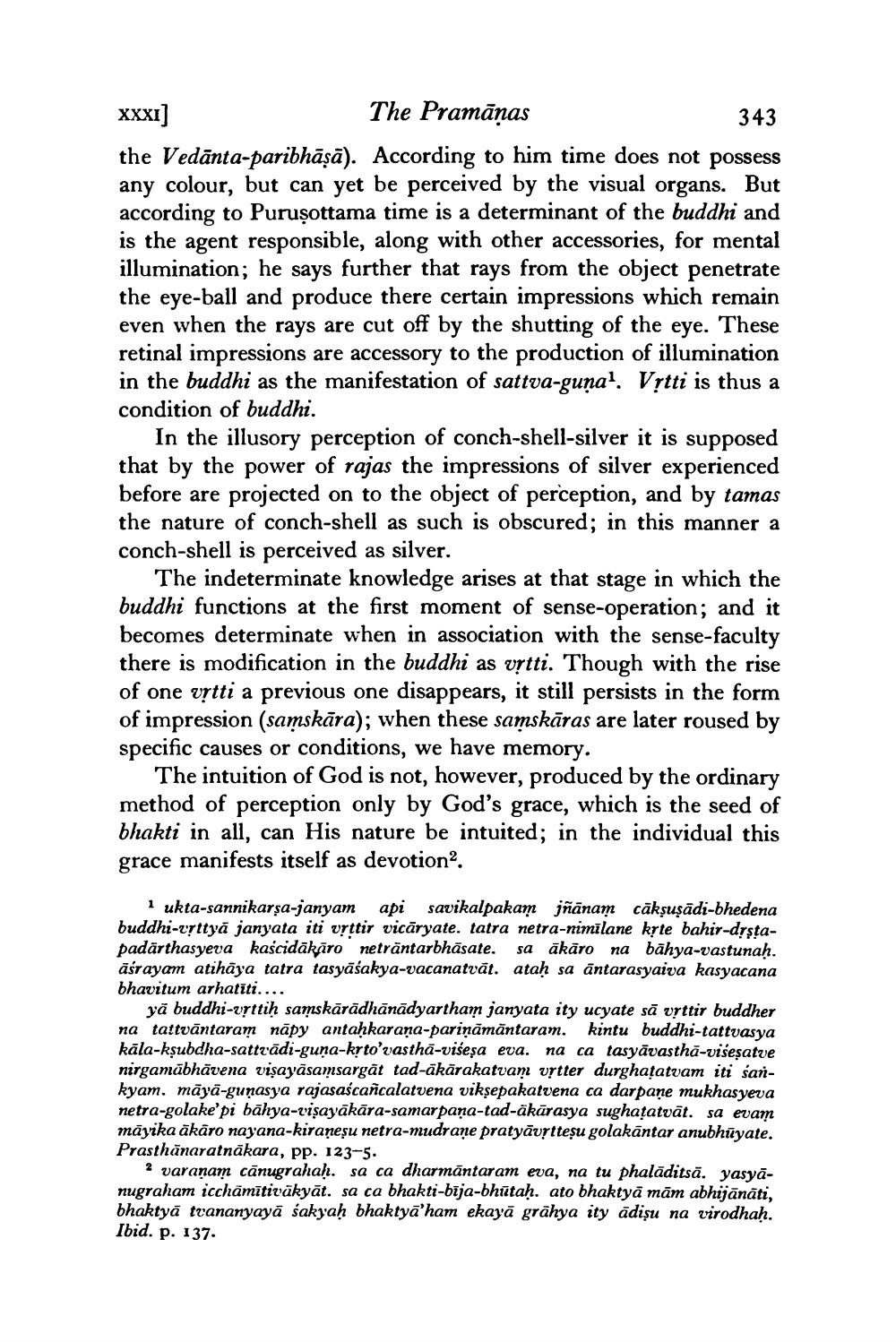________________
XXXI] The Pramāṇas
343 the Vedānta-paribhāṣā). According to him time does not possess any colour, but can yet be perceived by the visual organs. But according to Puruşottama time is a determinant of the buddhi and is the agent responsible, along with other accessories, for mental illumination; he says further that rays from the object penetrate the eye-ball and produce there certain impressions which remain even when the rays are cut off by the shutting of the eye. These retinal impressions are accessory to the production of illumination in the buddhi as the manifestation of sattva-guna?. Vịtti is thus a condition of buddhi.
In the illusory perception of conch-shell-silver it is supposed that by the power of rajas the impressions of silver experienced before are projected on to the object of perception, and by tamas the nature of conch-shell as such is obscured; in this manner a conch-shell is perceived as silver.
The indeterminate knowledge arises at that stage in which the buddhi functions at the first moment of sense-operation, and it becomes determinate when in association with the sense-faculty there is modification in the buddhi as vrtti. Though with the rise of one vrtti a previous one disappears, it still persists in the form of impression (samskāra); when these samskāras are later roused by specific causes or conditions, we have memory.
The intuition of God is not, however, produced by the ordinary method of perception only by God's grace, which is the seed of bhakti in all, can His nature be intuited; in the individual this grace manifests itself as devotion?.
1 ukta-sannikarşa-janyam api savikalpakam jñānam cākṣuşādi-bhedena buddhi-ryttyä janyata iti vrttir vicāryate. tatra netra-nimīlane krte bahir-drstapadārthasyeva kascidākaro netrāntarbhāsate, sa ākāro na bāhya-vastunah. asrayam atihāya tatra tasyāśakya-vacanatvāt. atah sa antarasyaiva kasyacana bhavitum arhatīti....
yä buddhi-vrttih samskārādhānādyartham janyata ity ucyate să vrttir buddher na tattväntaram nāpy antahkarana-pariņāmāntaram. kintu buddhi-tattvasya kāla-ksubdha-sattrādi-guna-krto'vasthā-višeşa eva. na ca tasyāvasthā-višesatve nirgamābhāvena vişayāsamsargāt tad-akārakatvam vrtter durghațatvam iti sankyam. māyā-guṇasya rajasascañcalatvena viksepakatvena ca darpane mukhasyeva netra-golake'pi bāhya-visayākāra-samarpana-tad-äkūrasya sughatatvāt. sa evam mājika ākāro nayana-kiranesu netra-mudrane pratyāvștteşu golakāntar anubhūyate. Prasthānaratnākara, pp. 123-5.
2 varanam canugrahah. sa ca dharmāntaram eva, na tu phalāditsā. yasyānugraham icchāmītivākyāt. sa ca bhakti-bīja-bhūtah. ato bhaktyā mām abhijānāti, bhaktyā trananyayā sakyaḥ bhaktyā'ham ekayā grāhya ity ādiņu na virodhah. Ibid. p. 137.




